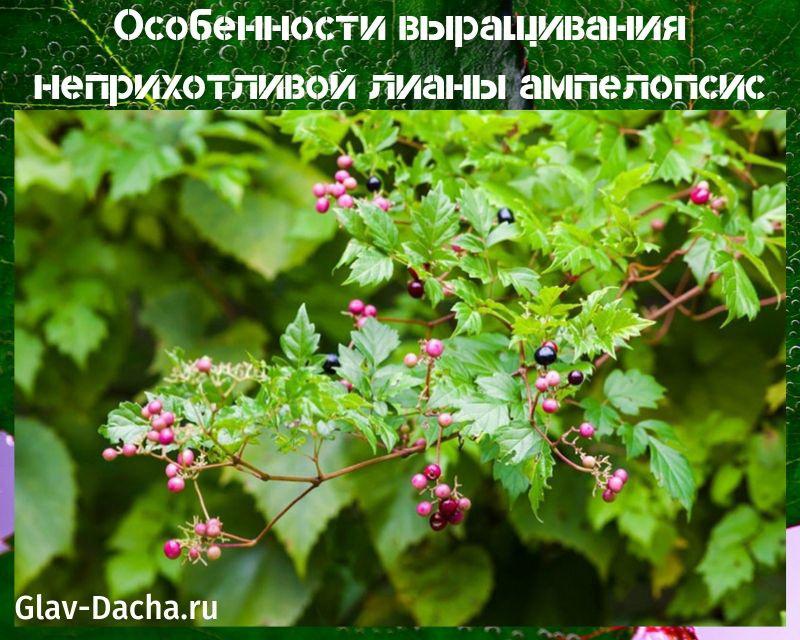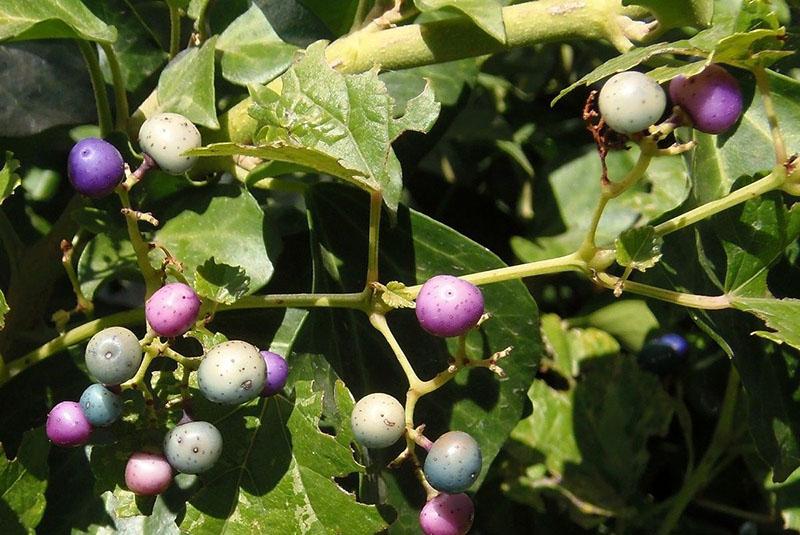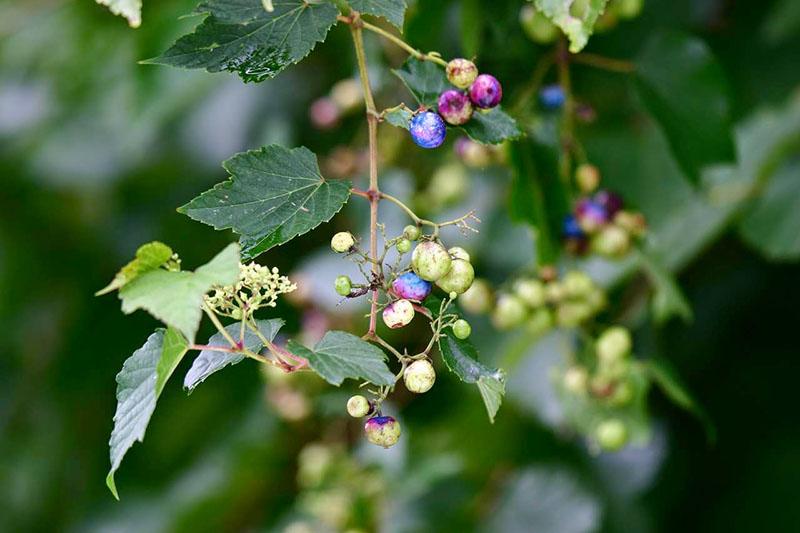Features of growing unpretentious ampelopsis vines
 An easy-to-maintain climbing plant is often used to decorate building facades and hedges. Ampelopsis has carved five-fingered leaves, in some species very similar to the familiar girlish grapes. In the fall, lush growth transforms into a crimson carpet and becomes even more decorative against the backdrop of dying nature.
An easy-to-maintain climbing plant is often used to decorate building facades and hedges. Ampelopsis has carved five-fingered leaves, in some species very similar to the familiar girlish grapes. In the fall, lush growth transforms into a crimson carpet and becomes even more decorative against the backdrop of dying nature.
In its natural environment, a deciduous liana with long (up to 10 m) pagons is common in Japan, China, Korea and the temperate regions of North America. Semi-lignified vines twine around trees, cover rocks, less often they are found in the form of low spreading bushes.
What does ampelopsis look like and its types in culture

Along the entire length of strong thin stems are attractive, regular palmate-lobed, leathery leaves, in some species with light spots. From April to June, peduncles with brushes of nondescript small flowers of light green or salmon color are formed in their axils. In warm southern regions, small berries are tied - pink, blue, blue, orange, purple. Closer to autumn, they create an additional decoration for the lush crimson crown.
Ampelopsis, or vineyard, is often confused with a similar parthenocissus, which clings to the support with special suction cups at the tops of the shoots. The described vine does not have such devices, its stems climb up with the help of twisted antennae.
In the genus Ampelopsis of the Grape family, according to The Plant List, there are 24 species.
Few of them are cultivated outdoors and indoors:
- variegated ampelopsis (A. heterophylla);

- heart-shaped ampelopsis (A. cordata);

- Japanese ampelopsis (A. japonica);

- ampelopsis aconitolistny (A. aconitifolia);

- ampelopsis Bodinier (A. bodinieri);

- short-flowered ampelopsis (A. brevipedinculata);

- eastern ampelopsis (A. orientalis).

Tips for growing vines
 For planting plants in the garden, choose a bright corner, illuminated for several hours a day by direct sunlight. In room conditions, a container with a vine is placed on the windowsill of the western or eastern window.
For planting plants in the garden, choose a bright corner, illuminated for several hours a day by direct sunlight. In room conditions, a container with a vine is placed on the windowsill of the western or eastern window.
The flower is considered fast-growing, so it will have to be transplanted often while it is young, and a mature plant - every 2-3 years.
 Planting and caring for ampelopsis does not differ in any special techniques. For growing vines in room culture, a light, loose soil mixture of neutral acidity is suitable, for example, any universal soil from the range of flower shops.
Planting and caring for ampelopsis does not differ in any special techniques. For growing vines in room culture, a light, loose soil mixture of neutral acidity is suitable, for example, any universal soil from the range of flower shops.
 Pruning is done annually in the spring, as uncontrolled stems soon take over a significant area, entwining nearby trees and buildings, and indoors - walls and curtains.
Pruning is done annually in the spring, as uncontrolled stems soon take over a significant area, entwining nearby trees and buildings, and indoors - walls and curtains.

It is advisable to direct the growth of the stems along the support, otherwise they destroy the plaster.
Apelopsis care
 The mode of moisturizing and feeding the vine differs at different times of the year.
The mode of moisturizing and feeding the vine differs at different times of the year.
 In summer, during active growth, the flower is watered abundantly, up to 3 times a week. Spring and autumn are necessary watering moderate, in winter and completely scarce, so that the rhizome of the plant in the dormant stage does not suffer from desiccation.
In summer, during active growth, the flower is watered abundantly, up to 3 times a week. Spring and autumn are necessary watering moderate, in winter and completely scarce, so that the rhizome of the plant in the dormant stage does not suffer from desiccation.
Ampelopsis is fed only during the growing season with complex mineral fertilizers for decorative deciduous plants, dissolving them in irrigation water.
 Spraying is not necessary, but in the summer heat, the liana gratefully responds to air moisture.
Spraying is not necessary, but in the summer heat, the liana gratefully responds to air moisture.
She does not like high air temperatures, the optimal thermometer readings for her are 17-20 degrees Celsius in summer and 8-10 degrees above zero in winter during rest.
 Propagated by apical cuttings, which are cut in the spring during formative pruning. Rooted in a peat-sand mixture under a film, maintaining a high moisture content of the soil mixture.
Propagated by apical cuttings, which are cut in the spring during formative pruning. Rooted in a peat-sand mixture under a film, maintaining a high moisture content of the soil mixture.
Diseases and pests, possible difficulties in keeping
 Despite the hygrophilia of the flower, an excess of irrigation water provokes rotting of the root system. This especially happens during a cool winter. It is almost impossible to save a liana with damaged roots, the only way out is to cut and grow new specimens.
Despite the hygrophilia of the flower, an excess of irrigation water provokes rotting of the root system. This especially happens during a cool winter. It is almost impossible to save a liana with damaged roots, the only way out is to cut and grow new specimens.
Lack of light and humidity affects flowering. Buds are either not formed at all, or formed in small quantities. Due to the lack of moisture in the soil and the surrounding air, the edges of the leaf blades often turn yellow and dry out. Of the pests on the plant, spider mites and thrips.
Ampelopsis is a very decorative liana, capable of creating a luxurious green decoration, shimmering with the gloss of leathery leaves, both in the garden and in the apartment.